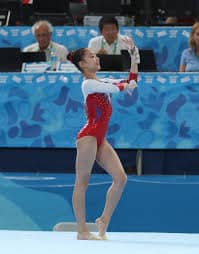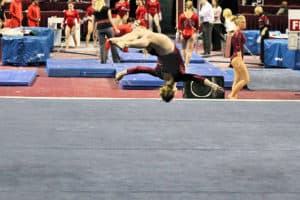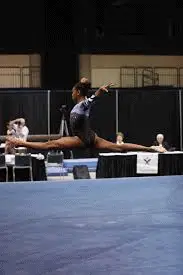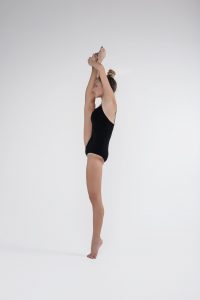This article has been updated to reflect the 2022-2026 DP Code of Points changes.
Level 6 floor routines are always a lot of fun to watch! Level 6 gymnastics is the first level in which the gymnast gets to use their own choreography. Level 6 floor music can be chosen by the gymnast and coach. Also, the requirements are basic, with no composition deductions for skills that aren’t difficult enough.
All of this leads to Level 6 floor routines that are focused on basics, along with artistry and rhythm. There’s enough time for the gymnast to show off her personality and enjoy competing. And that’s what we all want, right?
Philosophy Behind Level 6 Floor
The idea behind Level 6 gymnastics (and Level 7, too!) is to ease gymnasts into the optional levels, without the need to perform difficulty beyond the level’s requirements. For this reason, there are no composition deductions in these two levels. Composition deductions are deductions taken at the end of the routine, based on the construction of the routine. They can include deductions for lack of difficulty, too many similar skills, or failure to include certain skills in the routine.
In Level 6 and 7, these deductions are NOT applied. The goal is to create routines that meet the requirements and are performed as cleanly as possible. Often, the highest scoring routines are those that include the bare minimum number of skills, performed very well. There are general deductions that are taken at the end of the routine, such as rhythm and dynamics, and these deductions are still applied. But there’s no need to worry about exceeding the difficulty requirements. Just do what you can do well, and be done!

Value Parts for a Level 6 Floor Routine
Level 6 gymnasts need 5 A skills and 1 B skill on each event (bars, beam, and floor). All skills in gymnastics are evaluated based on their difficulty level, and they are given a value from A through E. A skills are the easiest, while B skills are a bit more difficult. The gymnast is allowed to choose the skills that she can perform the best in each of these difficulty categories. Each A skill is worth 0.10, and each B skill is worth 0.30. Deductions are taken off the Start Value if a skill is missing.
In a Level 6 floor routine, gymnasts are only allowed to perform A and B skills, plus ONE C dance skill. C acro skills are NOT allowed. Performance of more than one C dance skill, or any C or higher acro skill, will result in a 0.50 deduction from the Start Value for a restricted element.
Examples of B skills on floor include:
- Switch leap
- Side leap
- Straddle jump
- Pike jump
- Tuck jump 1/1 turn
- Straight jump 1 1/2 turn
- 1 1/2 turn
- Full turn with leg held at horizontal
- Front pike
- Front layout
- Back layout full
Special Requirements for a Level 6 Floor Routine
There are four Special Requirements for a Level 6 floor routine. Each Special Requirement is worth 0.50. If a Special Requirement is missing, it is a deduction of 0.50 off the Start Value.
The Level 6 requirements for floor are as follows:
- 3 element acro pass, min. 2 elements with flight
- Salto or aerial (2nd different acro connection)
- Dance passage x2, including one 180° leap
- Min. 360° turn on one foot
Here is more detail on each of these Special Requirements.
3 Element Acro Pass (2 with flight)

An acro pass is a tumbling pass consisting of at least one acro element. The acro pass in a Level 6 floor routine must consist of at least three acro skills, all directly connected.
A direct connection means that there can be no steps, hops, or loss of balance between the skills. Extra steps are common after a front handspring step-out, so if the gymnast uses this skill as the first or second skill in her pass, make sure she takes a long step forward into the next skill to avoid “double stepping”.
At least two of these acro skills must have flight. Examples of flight skills are:
- Roundoff
- Back handspring
- Front handspring
- Back tuck
- Back layout
- Front tuck
- Aerial cartwheel
- Aerial walkover
The gymnast can use any combination of allowable acro skills to make up this pass. However, rolls are not allowed in the acro pass. It’s fine to be basic or be creative, but make sure to use skills that the gymnast can perform with good form and technique!
Salto/Aerial
Examples of saltos are:
- Back tuck
- Back pike
- Back layout
- Back layout step-out
- Back layout full
- Front tuck
- Front pike
- Front layout
Examples of aerials are:
- Aerial cartwheel
- Aerial walkover
This requirement is IN ADDITION to the acro pass requirement and cannot be added to it. For example, if a gymnast performs the following pass, she will NOT get credit for both requirements:
Roundoff, back handspring, back handspring, back tuck = ONE Special Requirement
This is because the gymnast is required to do TWO acro passes to fulfill the two acro Special Requirements.
She can perform the salto/aerial as an isolated skill (example: front tuck by itself), or she can connect it to other skills (example: front handspring, front tuck).
The salto/aerial must land on the bottom of the feet first to get Value Part and Special Requirement credit. An example is a front tuck that lands on the back or the seat first will not get credit.
Note about awarding VP credit: ALL roundoffs, back handsprings, and front handsprings get VP credit if the acro pass includes a salto.
Dance Passage

The dance passage must consist of at least 2 skills from Group 1 (leaps, jumps, or hops). At least one of the skills in the dance passage must be a leap, which takes off from 1 foot, that achieves a 180° split.
There is an almost endless variety of combinations that a Level 6 gymnast can do to fulfill this requirement.
Some examples of 180° leaps are:
- Split leap
- Side leap
- Switch leap
- Tour jete
The dance passage is also a common place for gymnasts to perform their required “B” element. Some examples of dance “B” elements are:
- Switch leap
- Side leap
- Straddle jump
- Pike jump
- Jump 1 1/2 turn
- Tuck jump 1/1 turn
- Split jump 1/2 turn
- Shushunova
- Tour jete
- Ring leap
- Cat leap 1/1 turn
Min. 360° turn on one foot

This requirement is pretty self explanatory. The gymnast must perform at least a full turn on one foot. The free leg position is optional.
This is another good place for a Level 6 gymnast to get her “B” Value Part. Examples of “B” turns are:
- 1 1/2 turn
- Full turn with leg at horizontal
- Full turn with leg held by the hand in 180° split (similar to Memmel turn – see photo above)
- Full wolf turn
Caution: creative turns are more difficult, and are much more likely to be marked as incomplete. Incomplete turns (more than 90° incomplete) receive credit for the lower value part.
Also, if the gymnast does not hold her leg in the correct position throughout the entire turn, she will not receive “B” credit. This could result in a 0.30 deduction from the Start Value, if she was counting on that turn for her B.
Common Deductions for a Level 6 Floor Routine
In Level 6 gymnastics, the emphasis is on performing basic skills with excellent technique, to prepare for the higher levels. The routines that meet the requirements, with the cleanest execution, are the ones that will finish on top. In addition, these gymnasts will be the best prepared to move into Level 7 and beyond. What do I mean by “clean execution”? A gymnast with clean execution has minimal form deductions.
Here are some of the most common deductions that can occur during a Level 6 floor routine. These deductions are assessed each time they occur.
Common deductions include:
- Foot form – 0.05
- Concentration pause – 0.10 (2 seconds)
- Legs not parallel to floor in split or straddle-pike leaps/jumps – up to 0.20
- Insufficient split when required – up to 0.20
- Insufficient height (dance skills, aerials, or acro flight skills) – up to 0.20
- Insufficient height (saltos) — up to 0.30
- Incomplete turn/twist – up to 0.20
- Poor body position – up to 0.20
- Incorrect posture on landings of elements and dismount — up to 0.20
- Leg separation – up to 0.20
- Bent arms – up to 0.30
- Bent knees – up to 0.30
- Insufficient open of tuck/pike position prior to landing acro elements — up to 0.30
- Deep squat on landing — up to 0.30
- Fall – 0.50
- Coach on the floor — 0.50
General Deductions in a Level 6 Floor Routine
In a Level 6 floor routine, there are several categories of “general deductions”, which are evaluated by looking at the routine as a whole. These deductions are:
- Rhythm – up to 0.20
- Dynamics – up to 0.20
- Footwork – up to 0.20
- Posture/flexibility – up to 0.30
- Artistry – up to 0.30 (3 categories of artistry)
For more information on general deductions, see 6 General Deductions You’re Probably Getting.
Final Thoughts
The best Level 6 floor routines are clean, dynamic, and full of personality! As stated above, it’s best to choose skills that showcase the gymnast’s abilities. For instance, if the gymnast has poor flexibility, she might opt to perform only the minimum elements that require a full split, and use other skills to fulfill the rest of the requirements. If her feet aren’t as flexible, the routine might use choreography that doesn’t rely on fully pointed feet. You get the idea!
The top Level 6 floor routines will also show great rhythm, artistry, and footwork. The gymnast should should have quick, high tumbling, and clean dance skills with good form and flexibility. The judges love to see gymnasts selling their routines, and moving with the music during Level 6 floor routines, so keep working to show it off!
Further Reading
Tips and Resources for Level 6/7 Vault
Level 6 Bar Routine Recommendations
Level 6 Beam Routine Recommendations
Making Sense of Composition: Level 8 Floor
Making Sense of Composition: Level 9 Floor
Making Sense of Composition: Level 10 Floor
References
USA Gymnastics J.O. Code of Points, 2018-2022